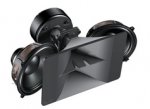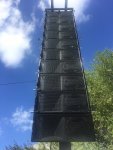No doubt...1 or 2 boxes is fun. That wears off quickly by box #11.
I assume you use Inventor, Solidworks or similar to model and design the finished assembly prior to building?
Initially it a was pencil, some graph paper and a calculator. Then the rough prototype shown at the top of this thread was built and tested. After that a Solidworks drawing was made.
I then paid for the CNC programing and another porotype was constructed out of MDF … - some modifications were made and then 17 boxes were cut out of plywood …
I of course did a lot of modelling with different 8" drivers - Max SPL, Xmax, box size and tuning etc. I also tested some arrays of the HF driver and horn.
Last edited:





